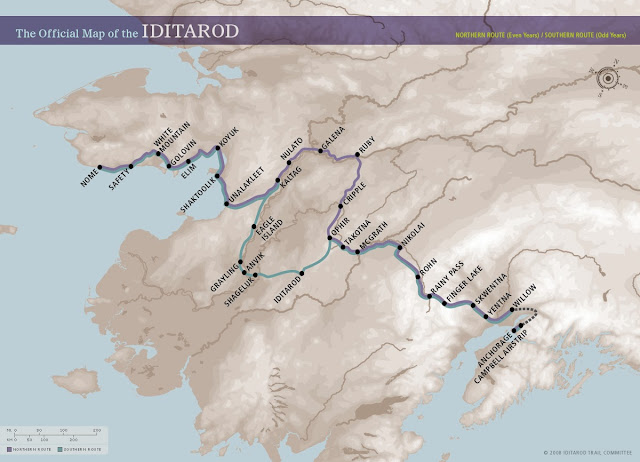- Back to Home »
- Học online cùng nhau , Kỹ năng đọc »
- Reading comprehension 1
Posted by : Unknown
7 tháng 11, 2013
Reading comprehension? You like it? Why not? We get it...
Cùng làm thử bài đọc hiểu dưới này nhé các bạn! Bài đọc dưới đây sẽ cung cấp cho các bạn những kiến thức nền cơ bản về con đường mòn huyền thoại đi Iditarod cũng như những thăng trầm lịch sử mà nó đã đi qua.
Article
In the early 1920's, settlers came to Alaska looking for
gold. They traveled by boat to the coastal towns of Seward and Knik, and from
there by land into the gold fields. The trail they used to travel inland is known today as the Iditarod Trail, one of
the National Historic Trails designated by the Congress of the United States.
The Iditarod Trail quickly became a major thoroughfare in Alaska, as the mail
and supplies were carried across this trail. People also used it to get from
place to place, including the priests, ministers, and judges who had to travel
between villages. In the winter, the settlers’ only means of travel down this
trail was via dog sled.
Once the gold rush ended, many gold-seekers went back to
where they had come from, and suddenly
there was much less travel on the Iditarod Trail. The introduction of the
airplane in the late 1920’s meant dog
teams were no longer the standard mode of transportation, and of course with
the airplane carrying the mail and
supplies, there was less need for land travel in general. The final blow to the
use of the dog teams was the appearance of snowmobiles.
By the mid 1960's, most Alaskans didn’t even know the
Iditarod Trail existed, or that dog teams had played a crucial role in Alaska’s
early settlements. Dorothy G. Page, a self-made historian, recognized how few
people knew about the former use of sled dogs as working animals and about the Iditarod Trail’s role in Alaska’s colorful
history. To raise awareness about this aspect of Alaskan history, she came up
with the idea to have a dog sled race over the Iditarod Trail. She presented
her idea to an enthusiastic musher, as dog sled drivers are known, named Joe
Redington, Sr. Soon the Pages and the Redingtons were working together to
promote the idea of the Iditarod race.
Many people worked to make the first Iditarod Trail Sled Dog
Race a reality in 1967. The Aurora Dog Mushers Club, along with men from the
Adult Camp in Sutton, helped clear years of overgrowth from the first nine
miles of the Iditarod Trail. To raise interest in the race, a $25,000 purse was
offered, with Joe Redington donating one acre of his land to help raise the
funds. The short race, approximately 27 miles long, was put on a second time in
1969.
After these first two successful races, the goal was to
lengthen the race a little further to the ghost town of Iditarod by 1973.
However in 1972, the U.S. Army reopened the trail as a winter exercise, and so in
1973, the decision was made to take the race all the way to the city of
Nome—over 1,000 miles. There were many who believed it could not be done and
that it was crazy to send a bunch of mushers out into the vast, uninhabited
Alaskan wilderness. But the race went! 22 mushers finished that year, and to
date over 400 people have completed it.
Questions
1) The primary purpose of this passage is to
A. recount the history of the Iditarod trail and the race
that memorializes it
B. describe the obstacles involved in founding the Iditarod
race
C. outline the circumstances that led to the establishment
of the Iditarod Trail
D. reestablish the important place of the Iditarod Trail in
Alaska’s history© Copyright Read Theory LLC, 2012. All rights reserved. 2
2) Based on information in the passage, it can be inferred
that all of the following contributed to the disuse of the Iditarod Trail except
A. more modern forms of transportation
B. depleted gold mines
C. highway routes to ghost towns
D. reduced demand for land travel
3) As used in paragraph 2, which is the best definition for
mode?
A. formula
B. way
C. preference
D. option
4) According to the passage, the initial Iditarod race
A. was funded through the sale of musher entrance fees
B. was founded by an advocate for Alaskan history
C. ended at the ghost town of Iditarod
D. boasted a total of 400 entrants
5) As used in paragraph 3, the phrase “self-made historian”
implies that Dorothy G. Page
A. was employed by the state to keep its dog sled history
alive
B. was determined to honor the glories of the gold rush in
spite of her questionable credentials
C. had pursued the study of Alaska’s history out of her own
interest
D. had personally educated others about Alaska’s history
6) In 1925, when a diphtheria outbreak threatened the lives
of people in the remote town of Nome, the government used the Iditarod Trail to transport medicine
nearly 700 miles to the town. If the author chose to include this fact in the passage, it would best fit
in
A. paragraph 1
B. paragraph 2
C. paragraph 3
D. paragraph 5
7) Based on information in the passage, it can be inferred that because the U.S. Army reopened the Iditarod Trail in 1972,
A. more people could compete in the Iditarod race
B. the mushers had to get permission from the U.S. Army to
hold the race
C. the trail was cleared all the way to Nome
D. the Iditarod race became a seasonal Army competition














